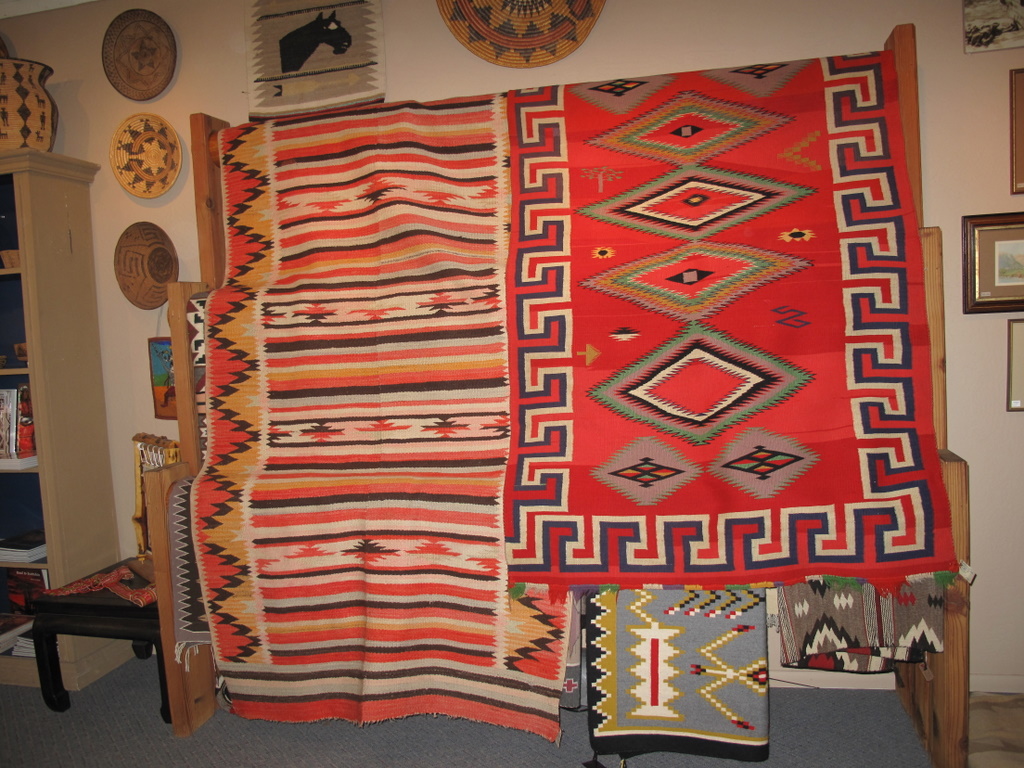The Brilliance of the Navajo Germantowns

A Rio Grande Blanket (left) and a Navajo Germantown weaving, both from the 1880's. These pieces are at the Old Territorial Shop in Scottsdale, AZ.
Tempe, AZ The Germantown period, which lasted from 1864 until about 1915, represents one of the most vibrantly creative eras in the history of Navajo weaving. The very existence of these textiles is a testimony to the perseverance and will to survive of the Navajo people. Although commercial yarns had been available to the Navajos in very small quantities, it was when the they were incarcerated at the Bosque Redondo near Ft. Sumner, New Mexico that these knitting yarns were introduced to them as a means of producing textiles for use and trade.
The Army had destroyed nearly all of the Navajos’ sheep and they had no other means of obtaining wool. They were living in holes they had dug in the ground, trying to farm in the alkaline plains near the Pecos and had lost many of their family members and their homes on the Long Walk of 350 miles to Hwééldí. In a triumph of will and dignity, they took the new materials, adapted the patterns of the Hispanic and Rio Grande weavings that they had seen and produced some of the most celebrated textiles in history. They continued to use the new yarns when they returned to their homeland in 1868, carefully rebuilding their flocks until they once again could once again use their own handspun for weaving, a process that took some 20 years. Please re-read this paragraph as you look at the pictures.
The pieces that survive are in collections, homes, museums and galleries all over the world, but many have remained in or have been returned to the Southwest. Once a year, as part of a class that I teach for the Fiber Factory on the Germantown period, I try to get a group of students together to see any Germantowns that may be displayed in several of the galleries near Main St. in Scottsdale. Over the next couple of days, you can take a virtual gallery walk with me and I’ll show you some of the weavings that grace their walls.
Our first stop was at the Old Territorial Shop. The owners, Deb and Alston Neal carry both contemporary and vintage work, and I wasn’t sure they’d have any examples of the Germantown period, but they had two that were absolutely wonderful. They also had a Rio Grande blanket that Alston graciously arranged next to one of the Germantowns for comparison (the picture is the one at the start of this post). The Rio Grande blanket is woven in two panels that were meticulously joined to make a wider blanket. The Germantown weaving on the right has interesting variations in the background color that appear to have been both deliberate and original.
The Old Territorial Shop also has an excellent example of the Late Classic period that shows the facility of the weavers with color and the creative way that they adapted designs. The weaving is behind the desk that is on your left as you into the gallery (see picture below) and is one of those weavings that seems to me to be more beautiful every time I look at it. Of course, being in a beautiful gallery is a nice advantage too. It is woven from handspun wool. The red was aniline dyed, the blues are indigo and the greens are indigo over rabbitbrush. Although it isn’t a Germantown, it does reflect the design influences that are seen in the period just after the Long Walk and dates from about 1875.
I like to think that the spirit of the weavers of these blankets lives on in the beautiful colors and patterns that they have left for us to appreciate.
Our next stop will be a little further down Main St. at the River Gallery. It might be Sunday before I can get it done, but you’ll get a good look at the warp threads and some really sophisticated design elements in a piece that they have right now.
Hagoshíí (so long for now)
Mary Walker
